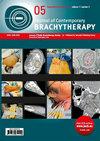60 岁以下患者的低剂量近距离放射治疗和长期治疗效果
IF 1.1
4区 医学
Q4 ONCOLOGY
引用次数: 0
摘要
目的:由于担心长期生化控制和治疗相关毒性,年轻男性接受低剂量近距离放射治疗在泌尿科医生中仍存在争议。本研究的目的是评估60岁以下男性接受碘-125(125I)LDR近距离放射治疗临床局部低危和中危前列腺癌的治疗效果。材料和方法:2003年至2016年期间,在我院接受125I单药治疗的所有临床局部前列腺癌连续患者均纳入研究。结果:共纳入161例患者,中位随访时间为6.8年(3-14.54年)。植入时的中位年龄为57岁(53-59岁)。确诊时前列腺特异抗原(PSA)的平均水平为 4.43 纳克/毫升(标准差 = 2.29)。大多数男性患有低风险前列腺癌(70.2%)。整个组群8年无生化进展生存率为94%。4年的PSA中位数为0.169(IQR,0.096-0.360),45%的患者PSA大于0.2。OS率为96.9%,有5例死亡报告,但只有1例继发于前列腺癌。据报道,18名患者(11.2%)出现了晚期泌尿生殖系统2级毒性反应。结论:我们的研究结果表明,LDR近距离放射治疗具有良好的长期治疗效果和极低的相关毒性,是年轻男性的有效治疗选择。本文章由计算机程序翻译,如有差异,请以英文原文为准。
Low-dose-rate brachytherapy and long-term treatment outcomes in patients younger than 60 years of age
Purpose:
Low-dose-rate (LDR) brachytherapy in young men remains controversial amongst urologists due to their concerns regarding long-term biochemical control and treatment-related toxicities. The purpose of this study was to evaluate the treatment outcomes of men under 60 years of age who underwent LDR brachytherapy with iodine-125 (125I) for clinically localized low- to intermediate-risk prostate cancer.
Material and methods:
All consecutive patients with clinically localized prostate cancer treated at our institution from 2003 to 2016 with 125I monotherapy were included in the study. Prescription dose was 145.0 Gy modified peripheral loading (MPD). All patients were assessed for biochemical progression-free survival using Phoenix definition (nadir +2 ng/ml), clinical progression-free survival, overall survival (OS), and any associated treatment toxicity.
Results:
A total of 161 patients were included, with a median follow-up of 6.8 years (range, 3-14.54 years). Median age at implant was 57 years (range, 53-59 years). Mean prostate specific antigen (PSA) level at diagnosis was 4.43 ng/ml (SD = 2.29). Majority of men had low-risk prostate cancer (70.2%). Biochemical progression-free survival at 8 years was 94% for the entire cohort. Median PSA at 4 years was 0.169 (IQR, 0.096-0.360), with 45% of patients having a PSA greater than 0.2. OS was 96.9%, with 5 deaths reported but only one was secondary to prostate cancer. Late grade > 2 genitourinary toxicities were reported in 18 patients (11.2%). Three patients (1.9%) developed secondary cancers, all considered unrelated to their LDR brachytherapy.
Conclusions:
With excellent long-term treatment outcomes and minimal associated toxicities, our results showed that LDR brachytherapy can be an effective treatment of choice in younger men.
Low-dose-rate (LDR) brachytherapy in young men remains controversial amongst urologists due to their concerns regarding long-term biochemical control and treatment-related toxicities. The purpose of this study was to evaluate the treatment outcomes of men under 60 years of age who underwent LDR brachytherapy with iodine-125 (125I) for clinically localized low- to intermediate-risk prostate cancer.
Material and methods:
All consecutive patients with clinically localized prostate cancer treated at our institution from 2003 to 2016 with 125I monotherapy were included in the study. Prescription dose was 145.0 Gy modified peripheral loading (MPD). All patients were assessed for biochemical progression-free survival using Phoenix definition (nadir +2 ng/ml), clinical progression-free survival, overall survival (OS), and any associated treatment toxicity.
Results:
A total of 161 patients were included, with a median follow-up of 6.8 years (range, 3-14.54 years). Median age at implant was 57 years (range, 53-59 years). Mean prostate specific antigen (PSA) level at diagnosis was 4.43 ng/ml (SD = 2.29). Majority of men had low-risk prostate cancer (70.2%). Biochemical progression-free survival at 8 years was 94% for the entire cohort. Median PSA at 4 years was 0.169 (IQR, 0.096-0.360), with 45% of patients having a PSA greater than 0.2. OS was 96.9%, with 5 deaths reported but only one was secondary to prostate cancer. Late grade > 2 genitourinary toxicities were reported in 18 patients (11.2%). Three patients (1.9%) developed secondary cancers, all considered unrelated to their LDR brachytherapy.
Conclusions:
With excellent long-term treatment outcomes and minimal associated toxicities, our results showed that LDR brachytherapy can be an effective treatment of choice in younger men.
求助全文
通过发布文献求助,成功后即可免费获取论文全文。
去求助
来源期刊

Journal of Contemporary Brachytherapy
ONCOLOGY-RADIOLOGY, NUCLEAR MEDICINE & MEDICAL IMAGING
CiteScore
2.40
自引率
14.30%
发文量
54
审稿时长
16 weeks
期刊介绍:
The “Journal of Contemporary Brachytherapy” is an international and multidisciplinary journal that will publish papers of original research as well as reviews of articles. Main subjects of the journal include: clinical brachytherapy, combined modality treatment, advances in radiobiology, hyperthermia and tumour biology, as well as physical aspects relevant to brachytherapy, particularly in the field of imaging, dosimetry and radiation therapy planning. Original contributions will include experimental studies of combined modality treatment, tumor sensitization and normal tissue protection, molecular radiation biology, and clinical investigations of cancer treatment in brachytherapy. Another field of interest will be the educational part of the journal.
 求助内容:
求助内容: 应助结果提醒方式:
应助结果提醒方式:


